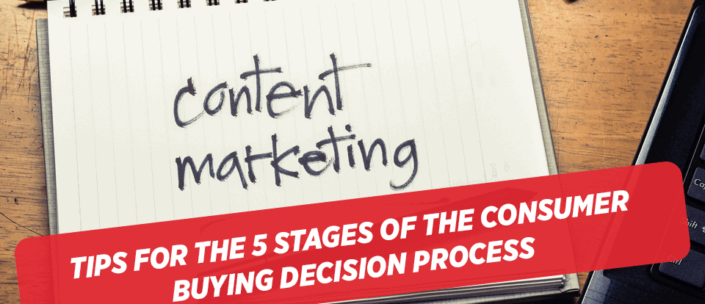If you’re a content marketer who got her start in writing, rather than marketing, then the consumer buying process might be something of a mystery to you. Maybe you’ve heard of it, along with other terms like “sales funnel.”
Well, marketers are as bad as any other professional when it comes to jargon, and that’s basically what these two terms are. The consumer buying process is just a breakdown of the steps people generally go through before making a purchase.
Different people may call each step something slightly different, but in general the stages are: awareness, evaluation, preference or alternative evaluation, purchase, and repurchase or post-purchase behavior.
And the sales funnel is a way to visualize how your audience shrinks as you get farther into the buying process. (In other words, lots of people may want to know about your product and take a step to do some research into your product, but a lot fewer will actually end up making a final purchase.)
Ideally, you want to be able to target people in every stage of the buying process. So how do you make your content marketing work for everyone? The answer is to create targeted content for people in each stage. Let’s go through them one by one.
You want your content marketing to target people in every stage of the buying process. Click To TweetAwareness
Customers at this point of the buying cycle are just starting to find out about your product. Maybe they heard or read something about it and it caught their interest; maybe a friend told them to check it out.
Or maybe they don’t even know about your product in particular yet – maybe they’re looking for the type of thing you make, like a blender or an iPhone case that’s also a wallet.
The key with content marketing for each stage is that you have to answer specific questions that arise in each stage. So for this early stage, one of those questions is “What does the customer need or think he or she needs?”
Since they’re not invested in your company or product yet, your strategy here is to make sure you show up in their searches for whatever thing it is you’re wanting to sell. If you’re making those iPhone cases, you want to make sure that your site and your content comes up when someone Googles “iPhone cases,” or maybe “multiuse iPhone cases,” or whatever else you’re seeing people search for using your analytics.
Your content for this stage could be fairly generalized, like “How to Choose the Best iPhone Case,” or “A Guide to Selecting the Right Blender for Your Needs.”
Then, once they’ve found you, you can move on to the next stage.
Evaluation
In this stage, people are looking at your product, deciding whether or not it will meet their needs. They’re also starting to compare it to other, similar products available.
Here, as you may have guessed, your job is to let those potential customers know why and how your product can solve their problem or meet their need. You’ll want to address the questions they’re sure to have – how much does the product cost? Is that a good value compared to other similar products? How do I know it’s of good quality? Is it easy to use?
Do a good job of answering these questions in the content you’re creating, and you’ll lead your customers further down the sales funnel and closer to making a purchase. So perhaps you’d write a blog post titled “How [your blender] Can Help You Eat More Healthfully and Gain Energy.”
Preference
This is when people are really figuring out whether or not they like your product enough to buy it. At this stage, they’ll probably be spending a good amount of time on your website, reading your product descriptions, reviews, and blog posts, and comparing it with what they see with your competitors’ sites.
And as storytelling has become more and more a part of successful marketing and branding, you can bet your customers will be looking for that, too – even though they might not be aware of it. You’ve got to take advantage of your own business’s story. If your business was started in the 1800s by your great-grandfather, that history should be prominently featured on your site. It’s part of what makes you stand out, what makes you different from the competition.
Storytelling should be integrated into your entire content marketing strategy, but this stage is where it becomes really critical. So maybe you’d write a blog post about how your product was featured in a particular TV show, or how your business donates a percentage of proceeds to a cause or charity. Now that people are interested in what you’re selling, you want to show them that there’s more to your product than just the function it performs.
Purchase
Congratulations! You’ve made it to the Emerald City: your customer is about to make a purchase. Running a sale? Offering discounts? Get the content that tells them about those offers out there. Post it on your website, send out emails, put it on your social media pages
Repurchase
This is where you cultivate brand loyalty. You don’t want people to just buy your product – you want people to love your product. You want to give them a reason to continue visiting your website, your social media pages, and to continue opening your emails.
Content for this stage could be anything from seasonal recipes to make with your new blender to cool iPhone case hacks – or even something as out there as the viral sensation Will It Blend? which actually was started by the blender company Blendtec.
You’ve probably seen the videos – a guy wearing a Blendtec jacket, safety goggles, and thick gloves tries blending all kinds of random, often expensive, things like an Apple Watch, the video game Halo 4, a pool cue, a Rubik’s cube…and it’s really funny. It’s the kind of content that you’ll come back to.
Since the Will It Blend? idea is taken (drat!), you’ll have to think of your own, but it doesn’t have to be quite as zany as sticking a crowbar in a blender. It should, however, be something that will give your customers a reason to think about your product or company after they’ve finished their transaction. Have some fun, get creative – and make sure to throw in some solid keywords for good measure.
Our content marketers are still working on our version of the Will It Blend? series, but in the meantime, we’d love to get to start helping you optimize your content so you can capture leads, no matter where they are in the buying process. Contact us today!







